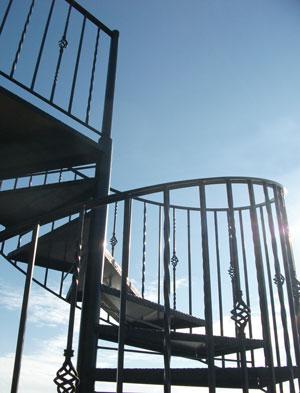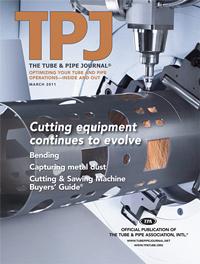- FMA
- The Fabricator
- FABTECH
- Canadian Metalworking
Categories
- Additive Manufacturing
- Aluminum Welding
- Arc Welding
- Assembly and Joining
- Automation and Robotics
- Bending and Forming
- Consumables
- Cutting and Weld Prep
- Electric Vehicles
- En Español
- Finishing
- Hydroforming
- Laser Cutting
- Laser Welding
- Machining
- Manufacturing Software
- Materials Handling
- Metals/Materials
- Oxyfuel Cutting
- Plasma Cutting
- Power Tools
- Punching and Other Holemaking
- Roll Forming
- Safety
- Sawing
- Shearing
- Shop Management
- Testing and Measuring
- Tube and Pipe Fabrication
- Tube and Pipe Production
- Waterjet Cutting
Industry Directory
Webcasts
Podcasts
FAB 40
Advertise
Subscribe
Account Login
Search
Old-school fabricator takes it one step at a time
Manufacturer relies on experience, ingenuity to make spiral staircases
- By Eric Lundin
- February 25, 2011
- Article
- Shop Management
When you hear the words "spiral staircase," what comes to mind? A foyer in an elegant hotel or an upscale home? An eye-catching feature that makes a lobby or an entrance hall unique? A flight of stairs that may have been fine decades ago, but wouldn't comply with today's strict building codes? If so, you'd be right on all counts except the last one. Building codes have changed, but they haven't eliminated the use of spiral staircases. Fabricators who make them have adapted to the changing codes, and twisting stairways continue to adorn businesses and residences to this day.
One such fabricator is Wells-Osborn Spiral Stairs, Genoa City, Wis. The company originally was founded by Bill Osborn in 1949 as a welding and repair shop. However, it wasn't long before Osborn found a niche in spiral stairways, railings, fences, gates, and other ornamental applications.
Anchors Aweigh!
Osborn had the ideal background, having served in the armed forces during World War II. The U.S. Navy taught Osborn to weld; being stationed on a Liberty ship gave him a lot of welding experience.
http://www.thefabricator.com/article/tc/old-school-fabricator-takes-it-one-step-at-a-time/edit"Those ships needed repair every time they fired the gun," said Ralph Wells, who bought the company from Osborn in 1989. Liberty ships weren't the most durable; several broke apart and sank without warning. The ones that made it through the war had been held together by prayers and frequent repairs at sea. Such duty hones a welder's self-reliance and ability to innovate, two skills that helped Osborn when he launched his shop three years after his discharge.
"A neighbor asked Bill if he could build a spiral staircase, and he figured he could do it," Wells said. Working out the pitch of the stairs (the rise and the run), the measurements of each step, and all the other dimensions for the first one probably required more brainpower than fabricating expertise, but Osborn was up to the task.
These sorts of challenges weren't all that foreign to Osborn.
"Somebody would start with, 'I don't know if you can do this, but...' and that got Bill going—he loved challenges," said Ed Adams, one of the company's two fabricators. "He'd start doodling, and while the guy was talking, he was thinking about the equipment he had in the shop, and what the equipment could do, and when the guy was done talking, Bill would put the piece of paper in front of him and say, 'Like this?' and often the guy would say, 'Exactly!'"
Building Equipment for Building Spiral Staircases. There wasn't much fabrication equipment available in the early days, and the equipment that did exist wasn't too sophisticated. Osborn had to use whatever he could get his hands on. Using a machine originally intended for rolling steel bands for wagon wheels, Osborn rolled steel bar into a circular shape to make the handrail and the stringer, the two components that twist. He used stamping presses to run punching dies to punch out various features and a press brake that he designed and built to bend the steps.
But that wasn't enough to make a complete staircase, so Osborn dreamed up the designs for a few machines. He used whatever he could find—cast-off hydraulic cylinders, speed reducers, appliance motors, and an automobile transmission—and cobbled together machines for bending ornamental scrolls, twisting square bar, and so on.
Although the company now has some modern equipment, including an ironworker for some of the punching and bending, Adams and Ray Jones, the second fabricator, still rely on a couple of Osborn's original machines.
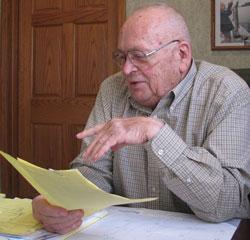
Owner Ralph Wells reviews a quote for a spiral staircase. Although the cost of freight restricts most orders to a distance of a few hundred miles, Wells-Osborn has shipped custom staircases all over the U.S.
"He made the scroll roller we still use today," Adams said, "He'd seen scrolls that were rolled to a half-circle, but he wanted something different—he wanted the scroll to curl up a bit more. So he'd figure out a way to make a machine that would do what he wanted."
The machine rotates at a moderate pace, and Adams has scribed chalk marks on the machine's base and the rotating table. After starting the machine's motor, Adams inserts a straight, narrow length of metal. He moves a lever that engages the drive system and watches closely as the table rotates and the metal bends. When the chalk marks are aligned, Adams moves the lever back to its original position to disengage the drive system and the table stops rotating.
Most shops have machines with CNC, touchscreen controllers, and digital readouts, but the staff at Wells-Osborn doesn't need them. Adams and Jones are akin to blacksmiths, using manual processes and working quite a bit by feel and intuition to form and shape metal. Experience counts for a lot. Adams has been with the company for 40 years, Jones for 10.
Spiral Staircase, Silent Salesman, or Both? Whether he realized it or not, Osborn was exceptionally fortunate to find this niche. He didn't have to put a lot of money into marketing; spiral staircases practically sell themselves.
"He started to make the first one, and the shop was visible from the street," Wells said. "Other people saw it and asked if he would make one for them. That was the beginning of the spiral staircase business."
In many cases, one sale leads to further sales.
"Every time we ship one of these things, it's like having another salesman out there," Wells said. "We'll put one of these on a deck on a home on a lake, and other people around the lake see it, and it starts a chain reaction. Pretty soon nearly every home on that lake has one."
"In the middle 1970s we were building 300 to 370 spirals a year," Adams said.
"There was a place called Vacation Village in Fox Lake, Ill.," Wells said. "They built hundreds of units, and they were very small. Each condo was about 600 to 800 square feet. Each unit had a 3-ft. 9-in. spiral that went from the first floor to the second floor. That's a small spiral, really small, but that's all they had room for. Osborn built all of them," he said.
Wells-Osborn does other decorative work too.
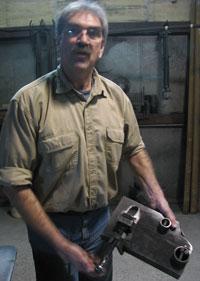
Several of the company’s machines, jigs, and fixtures were designed and built in-house. Fabricator Ed Adams demonstrates a jig for making minor changes in rolled bar.
"Frequently when we get an order for a spiral, we'll make a matching railing," Wells said. "Maybe the spiral goes to a deck, and the customer will say, 'Hey, make a railing for the deck too.'"
More Than Fancy. Although they are striking, spiral staircases are actually practical too.
"A spiral staircase takes up about half the space of a conventional staircase," Wells said. They also make a lot of sense for some exterior applications, such as connecting a second-floor deck to a first-floor patio when the deck is directly above the patio. A spiraling staircase, located off to one side, is ideal because it takes up little room.
That's not the only benefit.
"A spiral staircase is safer than a straight staircase," Wells said. While some straight staircases have a single handrail, every spiral staircase has two handholds—a handrail at the outside and a central pole at the inside. Also, if someone were to lose his balance or slip, a tumble would be stopped after making contact with the balusters and handrail.
Wells-Osborn's design is sturdy too.
"A bottom bar connects the heels of the treads, which distributes the load," Adams said. "When you step on it, you don't just load one nose and one heel; your weight is distributed over one nose and three heels."
"The bar is welded to the heel of every step," Wells said. "Then we run the pickets from the handrail to the bar. This forms a truss. Nobody else does that—we're the only company in the country that puts that bar in there," he said. "It's a stronger, safer stair."
DIY Installation
It's not enough to build a staircase and ship it. The fabricator needs a lot of information before it can design the staircase. Wells-Osborn has to know the transportation and installation details before it works up a design.
"We built a couple for a law firm in Chicago," Wells said. "They had offices on the 22nd and 23rd floors, and they didn't want their people to have to exit the office and use the elevator to go to the next floor. We had to make the staircase in sections so they would fit into the freight elevator."
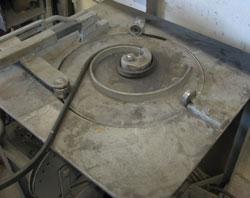
A scroll bender designed and built by the company’s original owner, which probably dates back 50 years, is still used almost daily.
"We usually use ½-in. square balusters," Adams explained. "Sometimes we'll split the staircase and use two ¼-in. by ½-in. balusters, and we tap them so they can be screwed together. To install it, you line up the two halves, join them with a couple of set screws, and when you're done you really can't tell that the staircase was made and shipped in two sections.
The only thing you'd see is a seam and some hardware."
On occasion a staircase comes in more than just two sections. Among the tallest Wells-Osborn made was a 52-ft.-high spiral that shipped in five sections.
"It was for a fine arts center for a high school," Wells said. "The stage had a catwalk that allowed people to change speakers and lights and this sort of thing."
Installing such a tall staircase with five sections isn't much more difficult than installing a short staircase in two sections, according to Adams.
"You slide one center tube into the next, install a set screw, and tighten it up," he said.
Likewise, for a homeowner, getting a spiral staircase into the home isn't hard. It might sound impossible, considering that modern codes stipulate that the minimum spiral width is 5 ft. and most doorways are 36 in. wide, but it's not.
"As long as you have a 36-in. doorway with clearance inside and out, you can fit one of our spiral staircases into your house," Adams explained. "You bring the stairway partway in, then corkscrew it as you go. Before long, you have it all the way in."
Wells-Osborn Spiral Stairs, 162 Walworth St., Genoa City, WI 53128, 262-279-5927, spirals@metalspirals.com, www.metalspirals.com.
About the Author

Eric Lundin
2135 Point Blvd
Elgin, IL 60123
815-227-8262
Eric Lundin worked on The Tube & Pipe Journal from 2000 to 2022.
About the Publication
subscribe now

The Tube and Pipe Journal became the first magazine dedicated to serving the metal tube and pipe industry in 1990. Today, it remains the only North American publication devoted to this industry, and it has become the most trusted source of information for tube and pipe professionals.
start your free subscription- Stay connected from anywhere

Easily access valuable industry resources now with full access to the digital edition of The Fabricator.

Easily access valuable industry resources now with full access to the digital edition of The Welder.

Easily access valuable industry resources now with full access to the digital edition of The Tube and Pipe Journal.
- Podcasting
- Podcast:
- The Fabricator Podcast
- Published:
- 04/16/2024
- Running Time:
- 63:29
In this episode of The Fabricator Podcast, Caleb Chamberlain, co-founder and CEO of OSH Cut, discusses his company’s...
- Trending Articles
Zekelman Industries to invest $120 million in Arkansas expansion

3D laser tube cutting system available in 3, 4, or 5 kW

Corrosion-inhibiting coating can be peeled off after use

Brushless copper tubing cutter adjusts to ODs up to 2-1/8 in.

HGG Profiling Equipment names area sales manager

- Industry Events
16th Annual Safety Conference
- April 30 - May 1, 2024
- Elgin,
Pipe and Tube Conference
- May 21 - 22, 2024
- Omaha, NE
World-Class Roll Forming Workshop
- June 5 - 6, 2024
- Louisville, KY
Advanced Laser Application Workshop
- June 25 - 27, 2024
- Novi, MI
























